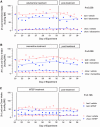Memantine reduces consumption of highly palatable food in a rat model of binge eating
- PMID: 20571841
- PMCID: PMC3020289
- DOI: 10.1007/s00726-010-0659-3
Memantine reduces consumption of highly palatable food in a rat model of binge eating
Abstract
Excessive consumption of highly palatable food has been linked to the development of eating disorders and obesity, and can be modeled in non-food-deprived rats by offering them a limited (2-h daily) access to an optional dietary fat. Since the glutamatergic system has recently emerged as a viable target for binge-eating medication development, we compared the effects of subchronic treatment with glutamatergic receptor antagonists to the effects of a reference appetite-suppressing agent sibutramine on highly palatable food (lard) and normal chow intake. In three separate experiments, the consumption of a standard laboratory chow and lard were measured during 12 days of medication treatment and for 6 days afterwards. Generalized estimating equations analysis demonstrated that sibutramine (7.5 mg/kg, p.o.) significantly decreased lard consumption, with a concurrent increase in chow consumption. Sibutramine effects disappeared after treatment discontinuation. The NMDA receptor antagonist memantine (5 mg/kg, i.p.) significantly decreased lard consumption and increased chow consumption, comparable to effects of sibutramine; however, memantine's effects persisted after treatment discontinuation. The effects of the mGluR5 antagonist MTEP (7.5 mg/kg, i.p.) on food consumption were in the same direction as seen with memantine, but the observed differences were not significant. In an additional control experiment, sibutramine and memantine reduced unlimited (24 h) chow intake during the treatment phase. Present results provide evidence that glutamatergic neurotransmission might be involved in the regulation of excessive consumption of highly palatable foods, and suggest that NMDA receptor may be an attractive target for developing obesity and disordered eating pharmacotherapies.
Figures



Similar articles
-
The uncompetitive N-methyl-D-aspartate antagonist memantine reduces binge-like eating, food-seeking behavior, and compulsive eating: role of the nucleus accumbens shell.Neuropsychopharmacology. 2015 Mar 13;40(5):1163-71. doi: 10.1038/npp.2014.299. Neuropsychopharmacology. 2015. PMID: 25381776 Free PMC article.
-
Antagonism of glutamatergic NMDA and mGluR5 receptors decreases consumption of food in baboon model of binge-eating disorder.Eur Neuropsychopharmacol. 2008 Nov;18(11):794-802. doi: 10.1016/j.euroneuro.2008.05.004. Epub 2008 Jun 24. Eur Neuropsychopharmacol. 2008. PMID: 18573641 Free PMC article.
-
Lisdexamfetamine suppresses instrumental and consummatory behaviors supported by foods with varying degrees of palatability: Exploration of a binge-like eating model.Pharmacol Biochem Behav. 2020 Feb;189:172851. doi: 10.1016/j.pbb.2020.172851. Epub 2020 Jan 10. Pharmacol Biochem Behav. 2020. PMID: 31931017
-
Pharmacological manipulations in animal models of anorexia and binge eating in relation to humans.Br J Pharmacol. 2014 Oct;171(20):4767-84. doi: 10.1111/bph.12789. Epub 2014 Sep 5. Br J Pharmacol. 2014. PMID: 24866852 Free PMC article. Review.
-
From taste hedonics to motivational drive: central μ-opioid receptors and binge-eating behaviour.Int J Neuropsychopharmacol. 2009 Aug;12(7):995-1008. doi: 10.1017/S146114570900039X. Epub 2009 May 12. Int J Neuropsychopharmacol. 2009. PMID: 19433009 Review.
Cited by
-
NMDA Receptors in Accumbal D1 Neurons Influence Chronic Sugar Consumption and Relapse.eNeuro. 2021 May 17;8(3):ENEURO.0029-21.2021. doi: 10.1523/ENEURO.0029-21.2021. Print 2021 May-Jun. eNeuro. 2021. PMID: 33906970 Free PMC article.
-
The role of memantine in the treatment of psychiatric disorders other than the dementias: a review of current preclinical and clinical evidence.CNS Drugs. 2012 Aug 1;26(8):663-90. doi: 10.2165/11634390-000000000-00000. CNS Drugs. 2012. PMID: 22784018 Review.
-
Converging vulnerability factors for compulsive food and drug use.Neuropharmacology. 2021 Sep 15;196:108556. doi: 10.1016/j.neuropharm.2021.108556. Epub 2021 Apr 20. Neuropharmacology. 2021. PMID: 33862029 Free PMC article. Review.
-
Gene variants in eating disorders. Focus on anorexia nervosa, bulimia nervosa, and binge-eating disorder.J Prev Med Hyg. 2022 Oct 17;63(2 Suppl 3):E297-E305. doi: 10.15167/2421-4248/jpmh2022.63.2S3.2772. eCollection 2022 Jun. J Prev Med Hyg. 2022. PMID: 36479493 Free PMC article. Review.
-
Long-Term NMDAR Antagonism Correlates Weight Loss With Less Eating.Front Psychiatry. 2019 Feb 8;10:15. doi: 10.3389/fpsyt.2019.00015. eCollection 2019. Front Psychiatry. 2019. PMID: 30800078 Free PMC article.
References
Publication types
MeSH terms
Substances
LinkOut - more resources
Full Text Sources
Other Literature Sources

